The Northern peoples recognize food as a gift of nature, which carries not only natural benefits, but also medical and ritual. For example, the medicinal properties of plants in the northern latitudes are known for their special power when properly processed. But the processing and storage of herbal medicines required “sedentariness”, so the northern nomads were rarely treated with medicinal plants. Their traditional cuisine includes roots of edible herbs, wild onions, and berries. The Dolgans are a nomadic people of the North and their diet is dominated by deer meat, bringing not only nutritional benefits, but also healthful.
The leading type of traditional economic activity of Dolgan is reindeer husbandry. That is why an important component in the Dolgan diet is deer meat, the biological value of which consists of macro and microelements (calcium, phosphorus, potassium, sodium, iron) and vitamins B3 and B. This meat is easily digested without any biological and vegetable additives. Deer meat, which feeds exclusively on plant foods (reindeer lichen (yagel), branches and leaves of low-growing plants, berries, mushrooms) belongs to environmentally friendly and safe products. It is consumed raw, boiled, dried, charqued (smoked) or frozen. [2]
Fish is eaten by all groups of the population, both reindeer breeders and residents of villages. In autumn and winter, stroganina (slices of frozen fish or meat served cold) is especially popular - frozen fish cut into long shavings: nelma (Siberian white salmon), muksun (whitefish), whitefish. In summer, the most popular dish is raw (freshly caught) fish (sagudai) or lightly salted fish. Boiled fish is eaten at all seasons. The preparation for future use of dried fish known as "yukola", "kardilyak" is also widely preserved.
Wild vegetable and vitamin-bearing plants are suppliers of vitamins, trace elements and other nutrients necessary for normal human life. Dolgans knew about this and were used in the diet as a healthdul food, since many of them contain biologically active substances that contribute to the prevention of certain human diseases.
The most detailed description of the traditional Dolgan cuisine was presented by Anna Alekseevna Barbolina, keeper of Dolgan culture and language, Candidate of Pedagogical Sciences, standout of education of the Russian SFSR, leading methodologist on Dolgan culture of the Taimyr House of Folk Art. Below you will see described Dolgan traditional dishes from her book “The Kitchen of my Childhood (Dolgan Traditional Cuisine)".

Boiled deer meat - aet kuehe - эт күөһэ.
The washed meat is put in large chunks in cold water and boiled for 30-40 minutes. The foam that appears during boiling is removed with a slotted spoon, and the fat that floats to the surface is also removed and used to toast Dolgan bread or served with meat. Add salt 10 minutes before cooking. The readiness of the meat is determined using a chef's needle (in Dolgan - urubiin). If urubiin freely pierces the meat and no ichor is released from the puncture, then the meat is ready. The meat cooked in this way turns out juicy, with a pleasant aroma and taste.
Especially tasty and nutritious are rich broths made from the meat of domestic deer, specially slaughtered for treats (in honor of the arrival of dear guests, for celebrations on the occasion of the birth of a child, a wedding). Venison is a dietary meat, so it is not cooked for long. The inhabitants of the tundra love venison with blood, without digesting the meat.
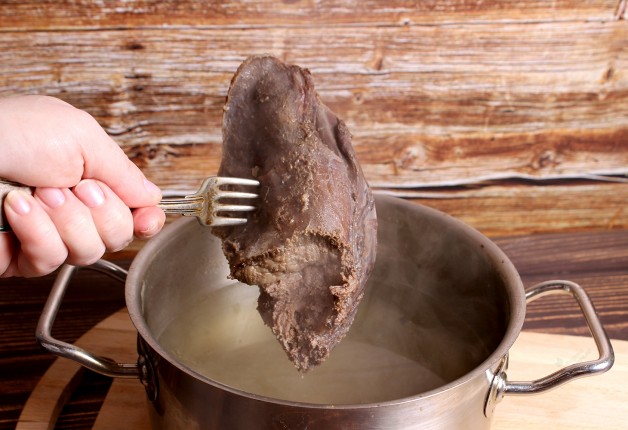
Meat soup – aet kues miine - heliei - эт күөс миинэ – һэлиэй
Meat broth was more often used in its pure form, it was not seasoned with anything. They were very rarely seasoned with flour to make it more satisfying. A few spoons (or a handful) of flour were diluted a little with cold water, rubbed so that there were no lumps, then diluted with broth and poured into the total mass, stirring in circles with a wooden spoon (bulaak), brought to a boil and boiled for 20-30 minutes until ready. The table was served in bowls or mugs.
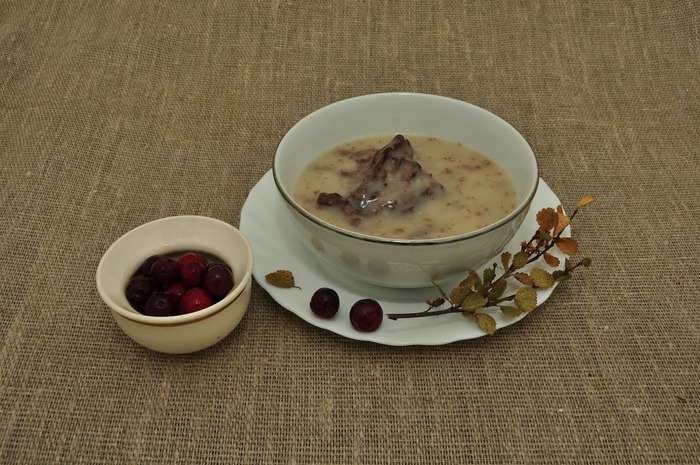
Melted reindeer fat – min hyata - мин һыата
The meat of a well-fed deer after cooking gives a good nutritious broth and a lot of melted fat. After the cooked meat has been removed from the hot broth, the melted lard is collected in a separate bowl and served as a component to a low-fat dish in hot form. After each cooking of meat, a decent amount of melted fat is collected. Sometimes melted hot bacon is poured over "aмaha" (amaha) – finely chopped boiled meat. This dish is called "amaha". Melted bone fat is also obtained from crushed (finely beaten) deer bones – оҥуоктартан (onguoktartan).
Deer blood soup - khaan butugaha - каан бутугаһа
As soon as the deer is slaughtered, the blood is drained into a basin or bowl, allowed to stand for a day at room temperature. Then the serum is separated to make blood sausage, the remaining blood is drained into a vat or pot, stirred and boiled for 30-40 minutes. This dish was used in traditional cuisine for the amateur and in the hungry post-war years. During the most stressful work seasons, the daily diet of reindeer herders and hunters is blood soup. Small pieces of frozen blood are dipped into boiling water. When cooking, stir with a wooden stirrer (ytyk) so that there are no lumps. Add salt 10 minutes before cooking. It is served on the table in bowls or in bowls with boiled meat.
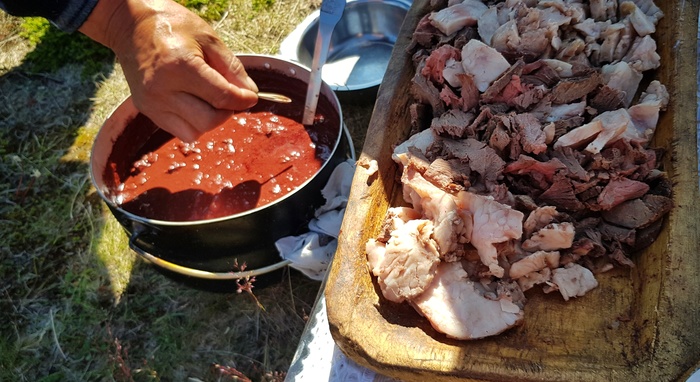
Blood sausage – choel - чөл
Serum is separated from the settled blood, salted, then the cleaned, washed insides (kutuya, khomorso, byychas, hulukta – mesh, abomasum, intestines) are filled and tightened with sharp special sticks.
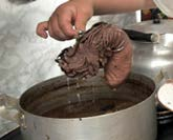
Cook the blood sausage and the rest of the insides in salted boiling water for 10-15 minutes. It also happens that the blood is poorly preserved. In this case, the blood is mixed very thoroughly, the prepared insides are filled and boiled. This dish is considered a delicacy. Blood sausage from the caecum, abomasum and stomach is prepared for all national rituals.

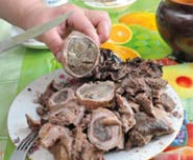 Kutuya, karyn – mesh, stomach.Homorso is an abomasum, an internal organ that serves for digestion.Bychas, hulukta – intestines (thick, thin).
Kutuya, karyn – mesh, stomach.Homorso is an abomasum, an internal organ that serves for digestion.Bychas, hulukta – intestines (thick, thin).
Photo source: The kitchen of my childhood (Dolgan traditional cuisine) / author-comp. A.A. Barbolina; ed. V.G. Zavarzin. – Krasnoyarsk: OOO "New Equipment and Technologies", 2022. – 72 p. – (Preserving the lessons of the ancestors). – ISBN 978-5-98708-150-1
The inner fat - ithir - итир
Ithir is the internal fat removed from the surface of the deer's stomach. This is done very carefully, immediately after butchering the deer carcass. The stomach is very large, and it is always full of undigested foods, easily squeezed through with fingers, which is completely undesirable.

Bychas in Dolgan are intestines with fat, they are simply well washed and dried. The internal fat is used, like all fats, for frying meat, for cooking cold cuts. Deer fat contains a large amount of saturated fatty acids, which is why it has a fairly high melting point. As you know, the diet of reindeer, especially in winter, is not very diverse, but most of the food eaten contains a lot of vitamins, for example, carbohydrates in the reindeer lichen (yagel).
The value of the internal fat of deer and fish is very well known. The inner fat is stored in special burbot skin bags. Washed and turned inside out dried deer intestines are used for ritual purposes (fed fire) if they are taken from a slaughtered personal deer. Dried ithir and bychas are fried in a frying pan and used as a seasoning for lean hot meat dishes. Melted lard from the intestines is eaten with meat or taken with you for food on the road, so that at any moment with a piece of Dolgan bread you can "starve a worm".
Reindeer milk - uut - үүт
Deer milk is thick, fatty, pleasant to the taste and resembles cream in consistency. It is consumed with tea. In winter, it is frozen, and children are served in small pieces like ice cream. Milk is consumed with tundra cloudberry. Rennet (homorso) is sometimes placed in a vessel with milk, the fermentation process takes place, and it thickens, it is eaten with a spoon. Milk (uut) is used as a healing dish. Mostly children enjoy it, and the older generation drinks with tea.
Stroganina (slices of frozen fish or meat served cold) from the liver, kidneys - ton byar, buer – тоҥ быар, бүөр
After cutting and processing the carcass, the liver and kidneys are drained, cut into strips 50-60 mm wide, placed on grass or snow, then on a clean plywood board and frozen. So, the liver is ready for consumption. At any time, according to need, they take the liver or kidneys, plan them and eat them, dipping them in salt. Sometimes the liver and kidneys are consumed as fresh meat, without freezing. Liver is whittled by amateurs, offered to children and adults with asthenia and large blood loss (women in labor, with trauma with blood loss).
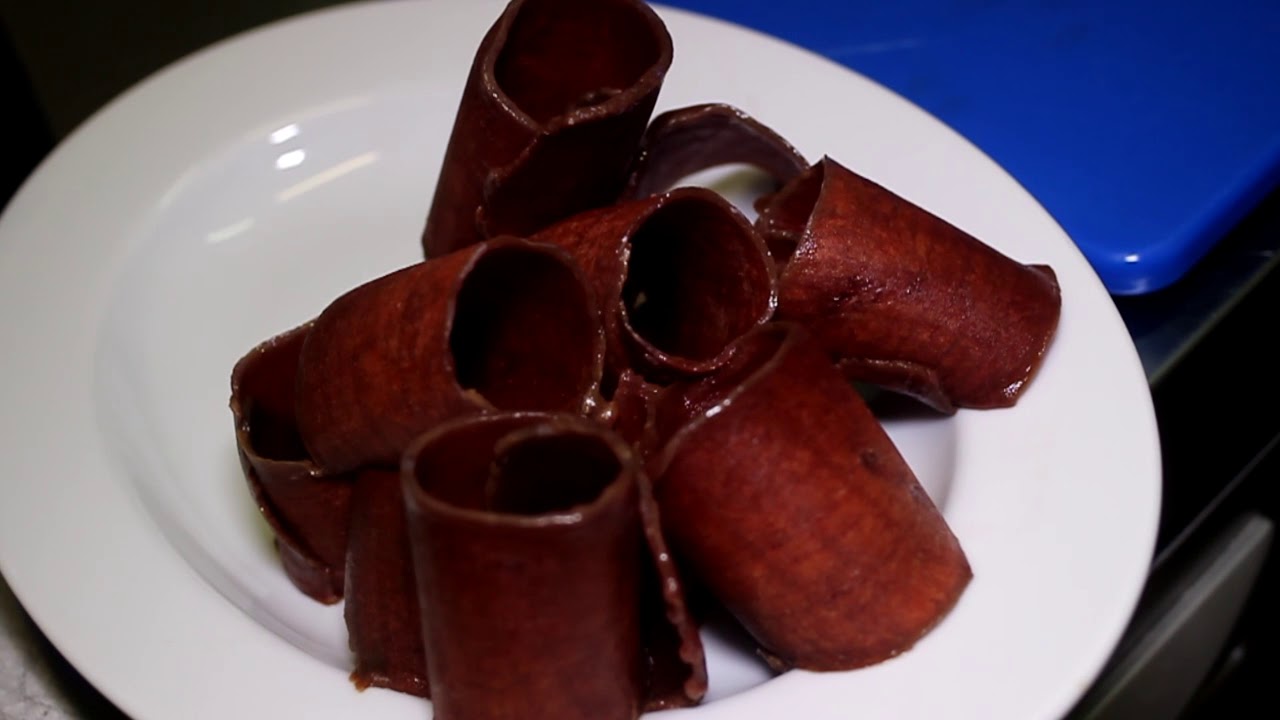
Liver baked in a campfire - ueluu - үөлүү быар
This food is prepared by hunters or teenagers during night duty in the herd. They take a willow twig, prick a piece of liver and bake it near the burning coals of the fire, make sure that it does not burn, turn it over depending on the size of the fire. So, the dish is ready – it is a delicacy, very useful for any organism.
Rib soup - oyogos mine - ойогос минэ
A variety of delicious dishes are prepared from the rib part of the deer. Like any meat, oyogos is thoroughly washed, chopped into pieces so that each rib has meat with fat. Then they are put in a pot with cold water, salted and put on fire. Piercing the oyogos with a fork (urubiin), determine the readiness: if clear juice is released, pull it out into a plate and serve with hot broth. Sometimes boiled oyogos is served as a cold snack. Oyogos is stewed in fat from broths or on the inside. Oyogos is baked over a campfire, like the liver, strung on willow twigs.

Oyogos (agys oyogos), as a deer is slaughtered, hung on a tripod, blood flows from it. In the air, it is covered with a crust, as if it dries, then it is dried, and stored in this form for longer.
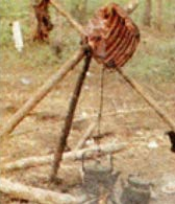
Photo source: The kitchen of my childhood (Dolgan traditional cuisine) / author-comp. A.A. Barbolina; ed. V.G. Zavarzin. – Krasnoyarsk: OOO "New Equipment and Technologies", 2022. – 72 p. – (Preserving the lessons of the ancestors). – ISBN 978-5-98708-150-1
Deer's tongue - tyl - тыл
The deer's head is cut up, the tongue is taken out separately and frozen. Tongues are usually intended for a festive table, for this they are thoroughly washed and put in cold water, boiled for 30-40 minutes, and salt is added 10 minutes before cooking. Boiled tongue is consumed both warm and cold, cut into thin slices into a plate and served on the table.

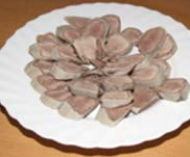
The rich broth from the tongues is used for cooking Dolgan soup – heliei (flour soup). Languages (tylynan) are treated to guests, and children feast on them. In everyday food, it is almost not consumed, it is saved for a special occasion.
Photo source: The kitchen of my childhood (Dolgan traditional cuisine) / author-comp. A.A. Barbolina; ed. V.G. Zavarzin. – Krasnoyarsk: OOO "New Equipment and Technologies", 2022. – 72 p. – (Preserving the lessons of the ancestors). – ISBN 978-5-98708-150-1
Assorted (meat, internal fat, leg brain) - amaha

To prepare this dish, take the already dried fat layer from the intestines (the shell is itir, acha) and cut very finely into pieces on a board so that this mass melts quickly and evenly. After that, it is put in a frying pan and put on the oven, melted, stirring often so that it does not burn. While the fat is melting, boiled deer meat is cut into small pieces (cubes), then mixed with cooked internal fat 5 minutes before cooking. After the pan is removed from the stove, put in a cool place and add frozen bone marrow (hilii), salt to taste. The finished assorted (amaha) is removed from the pan, wrapped in foil or put in a bag made of burbot or pike skin, and stored in a cold place. Thus, this mass cools down, it turns out a very tasty and beautiful multicolored assorted - amaha. The table is served in slices on a plate. This is a festive meal, it is served to the guests.
Photo source: The kitchen of my childhood (Dolgan traditional cuisine) / author-comp. A.A. Barbolina; ed. V.G. Zavarzin. – Krasnoyarsk: OOO "New Equipment and Technologies", 2022. – 72 p. – (Preserving the lessons of the ancestors). – ISBN 978-5-98708-150-1
Fresh meat - ton aet, tobuk, buelde, hilii, irge - тоҥ эт, тобук, бүлдэ, һилии, иргэ
The fore and hind limbs are folded separately when cutting and processing the carcass. Skin is removed from the legs, muscle tissues are cut, muscle fibers (tobuk, bulde) are cut into small pieces and consumed fresh, dipped in salt.
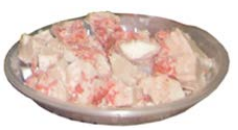
The leg bones, disassembled by joints, are crushed with a Dolgan knife and the bone marrow is extracted. Bone marrow (hilii) is fat, a delicacy. Hilii is consumed fresh, sometimes frozen and served with boiled or dried meat. How fresh meat is consumed by the brain – irge. Most often, irge is frozen and planed as a by-product of the first category in terms of nutritional value.
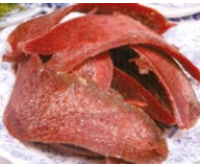
Calf muscles – bulde – are the most delicious. First, the tendons are separated from them, cleaned of meat and split. Long fibers are cut into short pieces and served, as a rule, before the main meal. One end of the tendon fiber is taken in the teeth and cut off near the lips with a knife. Muscles are eaten and scalded. The brain – irge – is eaten raw. It is considered a very high-calorie and delicious food.
Photo source: The kitchen of my childhood (Dolgan traditional cuisine) / author-comp. A.A. Barbolina; ed. V.G. Zavarzin. – Krasnoyarsk: OOO "New Equipment and Technologies", 2022. – 72 p. – (Preserving the lessons of the ancestors). – ISBN 978-5-98708-150-1
Dried meat - ulukte - үлүктэ
Deer meat is stored for future use – it is dried, receiving ulukte. Dried meat is harvested in spring and summer. If the slaughter is carried out in winter, the meat is frozen and stored until the onset of warm weather.

In the spring, it is put in the snow. Winter meat freezes in a few months, loses a lot of moisture, and drying it does not take much time. In addition, winter meat is more fatty. Exsanguinated meat – pulp (thin or thick edge, upper or inner part of the hind leg), stripped of films and tendons, cut into long pieces 6-8 cm wide and hung outside. As it dries, it is turned over, smoked a little, and then hung out again. And so on until completely dry. Ulukte is stored in a bag, protecting it from moisture. Before serving this dish on the table, other housewives crush it, for this they take a flat stone (dire), a hammer.
The crushed meat is served with bone fat (onuok hyata or hilii). Sometimes the ulukte, without bringing it to complete drying, is cut into small pieces (cubes) and dried on an oilcloth, stirring often, turning it over. Some housewives add a little salt to the meat for ulukte. Soup is cooked from dried meat (ulukte) in the absence of fresh. Ulukte can be eaten without fat, like sunflower seeds.
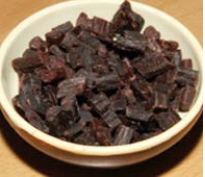
Photo source: The kitchen of my childhood (Dolgan traditional cuisine) / author-comp. A.A. Barbolina; ed. V.G. Zavarzin. – Krasnoyarsk: OOO "New Equipment and Technologies", 2022. – 72 p. – (Preserving the lessons of the ancestors). – ISBN 978-5-98708-150-1
Deer heart - hurek - Һүрэк
The heart is a particularly high–calorie and satisfying meal. It is cooked for a short time, until it is fully cooked. Deer heart (hurek) – a by-product of the first category in terms of nutritional value – is used as a delicacy.

The frozen heart (ton hurek) is whittled, consumed as a fish stroganina. The heart is fried. The inner fat (ithir) is cut into small pieces, put in a frying pan.
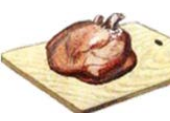
Cut the heart into thin plates and fry for 7-10 minutes. A few minutes before cooking, salt is salted and served on the table. The heart should not be overcooked, as it loses its juiciness and becomes hard. The heart (hurek) is boiled for 7-10 minutes, without digesting, so that it is juicy. The boiled heart is served both warm (immediately after removal from the broth) and cold.
Photo source: The kitchen of my childhood (Dolgan traditional cuisine) / author-comp. A.A. Barbolina; ed. V.G. Zavarzin. – Krasnoyarsk: OOO "New Equipment and Technologies", 2022. – 72 p. – (Preserving the lessons of the ancestors). – ISBN 978-5-98708-150-1
Bone broth and jelly - onuok miine - oҥуок миинэ
Dolgans are very practical, economical, they knew well that venison is a full–fledged high-calorie product with a high content of vitamins and trace elements, so they used everything – even processed bones, extracted fat and got rich broth, made jelly.
To do this, the bones of the fore and hind limbs (periarticular) were collected separately in a bag, the hooves were cut up, and all the bones were collected after each cooking of meat. When a lot of bones accumulated, they were crushed and put into a large tank or cauldron together with muscle tissues, muscle fibers, meat trimmings and cooked for a long time (5-8 hours), periodically removing fat. This made it possible to extract soluble substances from the bones as much as possible and destroy them minimally. Then they pulled out pieces of meat, muscle fibers, sugar bones and poured thick broth, left to cool in deep bowls – this is how jelly was obtained. Hot broth and thickness were served to the elderly. With such cooking, a lot of bone fat was obtained, which solidified, and it was used with boiled or dried meat, Dolgan bread (koetoeguu) was dipped into it or consumed in frozen form as butter.
Hare dishes - kuobaktan astar - куобактан астар
Hare soup - kuobak miine - куобак минэ
The skin is removed, the internal organs are extracted, exsanguinated, the carcass is cut into pieces, thoroughly washed, put in a saucepan and poured with boiling water. Bring to a boil, salt and cook for 35-40 minutes over low heat, periodically removing the foam that appears on the surface of the broth. Then the broth is seasoned with flour, and Dolgan soup is obtained. The pieces of meat are laid out in a large dish and served on the table. It is served separately with soup in bowls. Hare meat (kuobak ete) is considered a dietary dish, therefore it is very popular at all times.
Fish dishes - baliktan astar - балыктан астар
Fish is a favorite and obligatory dish in the Dolgan diet. Broad whitefish, whitefish, Arctic cisco, burbot, and lake salmon are caught in the lakes. Fish contains proteins, fats, minerals, and vitamins. It contains a lot of phosphorus, which the human body needs. The fish has a tender flesh, and it is easily absorbed by the body.
Fish oil is famous for two things – not a particularly pleasant taste and exceptional benefits for the human body. Fish is not only dried and air-dried, but also frozen or fat is obtained from fish. There are many ways of cutting fish, each of which is aimed at obtaining a specific end product. Despite the differences in the types of products obtained, the methods of butchering are basically similar. When cutting, first remove the scales or skin from the fish. It is recommended to peel the fish from the scales on the day when you gut it. But first, wash the fish in water for a few seconds to soften the scales and mucus. The scales must be removed from the tail side. First, the fins are cut around to a depth of 1 cm and break out of the body, but simple cutting is allowed.
Evisceration is most common and is used for most fish species. Abdomen is cut between the pectoral fins from the head to the anus, the insides are completely removed, the abdominal cavity near the spine is cleaned of blood clots, the head is not yet cut off.
Photo source: Delvaneo Website. URL: https://delvaneo.ru/kulinarnye-retsepty/sposoby-i-priemy-razdelki-ryby.html

Fried fish in small pieces - baarki - бааркы
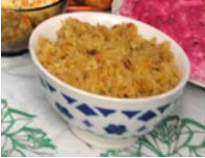 Fish (broad whitefish, whitefish, big powan, trout, char) are processed and cut into fillets with skin without bones. The bellies are strung separately, allowed to dry slightly (hung on poles for 8-10 hours). It is better to cook baarky from slightly dried fish – moisture evaporates from raw fish for too long. The prepared fish, bellies are cut into portions, then put in a preheated frying pan, sprinkle with salt and fry until an amber crust of golden color forms, stirring, crushing into small pieces. This dish is cooked for a long time – until the mass becomes dark golden in color. This is a hearty and delicious dish, which is also well stored. Baarky, made from only bellies, is especially tasty. Previously, the baarky was tightly stuffed into cauldrons and buried in the ground – so it was stored for a very long time. Baarky is harvested in large quantities in enameled dishes, filled with fish oil. This precious dish is stored for a very long time, used as a healing remedy in winter. Baarky is considered a delicacy for Dolgans, they are treated to guests.
Fish (broad whitefish, whitefish, big powan, trout, char) are processed and cut into fillets with skin without bones. The bellies are strung separately, allowed to dry slightly (hung on poles for 8-10 hours). It is better to cook baarky from slightly dried fish – moisture evaporates from raw fish for too long. The prepared fish, bellies are cut into portions, then put in a preheated frying pan, sprinkle with salt and fry until an amber crust of golden color forms, stirring, crushing into small pieces. This dish is cooked for a long time – until the mass becomes dark golden in color. This is a hearty and delicious dish, which is also well stored. Baarky, made from only bellies, is especially tasty. Previously, the baarky was tightly stuffed into cauldrons and buried in the ground – so it was stored for a very long time. Baarky is harvested in large quantities in enameled dishes, filled with fish oil. This precious dish is stored for a very long time, used as a healing remedy in winter. Baarky is considered a delicacy for Dolgans, they are treated to guests.
The “duty” dish - kabardaak - кабардаак
The first option: sometimes, when the fish is dried in bad weather, it does not dry well and can spoil. To prevent the yukola (sun-dried fish) from spoiling, kabardaak is made from it. Fins and darkened areas are cut off from the fish layers. A small yukola is cut in half, a large one is cut into several pieces. Put it in a flat large saucepan and, adding a little fish oil, put it on the fire, closing the lid. The mixture is constantly stirred with a wooden spoon, crumbled so that it is a homogeneous mass, then caviar is added. If the mass is a little dry, add fish oil and bring it to readiness, stirring constantly so that it is creamy in color.
The second option: after washing, the gutted fish is plastered – cut in half along the spine, and fillets without bones are obtained. The prepared fish is cut into portions, then put in a preheated frying pan, greased with fat, if there is caviar, then it is also used together with fillets. The dish is salted and fried until cooked, stirring constantly. For this dish (kabardaak), all kinds of fish are used, even those that lag behind the bones (slightly laid down). This is the duty dish of housewives. If there are a lot of fish, then the caviar is collected separately and kabardaak is prepared from it. Kabardaak from caviar is a delicacy.
Salted caviar - tuustaak istek - туустаак истэк

In fish cleaned of scales (broad whitefish, whitefish, big powan, herring), the abdomen is cut, holding it with the left hand and moving the knife from the head to the tail. Then, with the right hand, carefully, so as not to damage the gallbladder, the insides are removed. Caviar is collected separately (istek).
They are very carefully cleaned from mats, sprinkled with salt to taste and served on the table for making sandwiches. Sometimes some housewives and the most avid fishermen consume the caviar of freshly caught chira at once. Caviar (istek) is frozen for long-term storage without any spices.
Photo source: The kitchen of my childhood (Dolgan traditional cuisine) / author-comp. A.A. Barbolina; ed. V.G. Zavarzin. – Krasnoyarsk: OOO "New Equipment and Technologies", 2022. – 72 p. – (Preserving the lessons of the ancestors). – ISBN 978-5-98708-150-1
Dried fish - kak - как
 Large gutted fish (broad whitefish, whitefish, bulltrout) are plastered – cut in half along the spine – boneless fillets are obtained (the vertebral bone, head and rib bones are removed). The prepared fillet is cut across to the skin in frequent rows (6-8 mm), and the fleshy places (back) are cut lengthwise, beautiful even cubes are obtained, but at the same time it is impossible to damage the skin. The fillets are carefully hung on poles to dry, then lightly smoked over a campfire. Dried fish of this type (as) is stored for a long time, because it is made from the largest fatty fish. Kak is a very satisfying dish.
Large gutted fish (broad whitefish, whitefish, bulltrout) are plastered – cut in half along the spine – boneless fillets are obtained (the vertebral bone, head and rib bones are removed). The prepared fillet is cut across to the skin in frequent rows (6-8 mm), and the fleshy places (back) are cut lengthwise, beautiful even cubes are obtained, but at the same time it is impossible to damage the skin. The fillets are carefully hung on poles to dry, then lightly smoked over a campfire. Dried fish of this type (as) is stored for a long time, because it is made from the largest fatty fish. Kak is a very satisfying dish.
Photo source: The kitchen of my childhood (Dolgan traditional cuisine) / author-comp. A.A. Barbolina; ed. V.G. Zavarzin. – Krasnoyarsk: OOO "New Equipment and Technologies", 2022. – 72 p. – (Preserving the lessons of the ancestors). – ISBN 978-5-98708-150-1
Dried fish - kerdiileek - кэрдиилээк
 They eat fish fresh, prepare it for the future, kerdiileek is the oldest way of harvesting fish without salt. Large and medium–sized fish are chosen for it - mainly broad whitefish, northern whitefish, whitefish or ciscos.
They eat fish fresh, prepare it for the future, kerdiileek is the oldest way of harvesting fish without salt. Large and medium–sized fish are chosen for it - mainly broad whitefish, northern whitefish, whitefish or ciscos.
They are cleaned of scales, the abdominal fin is separated with circular movements of a knife, a longitudinal incision is made along the abdomen and the insides are extracted. In large fish, the bellies can be cut out – they are dried separately. The carcass, cleaned of scales, is placed on a cutting board with its belly facing the divider. With the left hand they hold the head, and with the right they make the first incision from the base of the pectoral fin along the spine. The incision ends before reaching 2 cm to the caudal fin, and similarly, on the other hand, in depth it divides the fish into two parts along the ridge. A small longitudinal incision 4-5 cm long is made in the pulp of the back and the head, insides are separated and cleaned of blood, then the ridge is carefully chopped off at the base of the caudal fin. After the fillet, the fish is cleaned from the ribs.
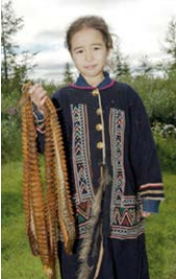
Turn the side layers with the pulp upwards. Carefully, in order not to damage the skin, transverse parallel incisions are made on the flesh at a distance of 5-7 mm from each other. Then, holding the upper edge with the tip of a knife, the layer is slightly stretched. Both kerdiileek, and dogdur, and holguok are hung on specially prepared tripods and a pole with the pulp down. This spinal part with the pulp of the dorsum and the dorsal fin is called a holguok. A thin stick is passed through the hole in the pulp and hung to dry. You can not separate the spine from the dorsal layer, but cut off only the ribs and the head. In this case, three layers of flesh (two lateral and dorsal) are held on the caudal fin. The bellies are dried separately, strung on a stick, used for cooking other dishes – baarky, and sometimes for kabardaak.
Photo source: The kitchen of my childhood (Dolgan traditional cuisine) / author-comp. A.A. Barbolina; ed. V.G. Zavarzin. – Krasnoyarsk: OOO "New Equipment and Technologies", 2022. – 72 p. – (Preserving the lessons of the ancestors). – ISBN 978-5-98708-150-1
Dried fish - djuhaala - дьуһаала
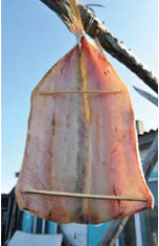 Small fish – litle cickos and whitefishes – are cut up in the same way as on the kerdiileek, but without transverse incisions on the flesh. This is called a djuhaala. In good weather, the fish dries up in two days. Previously, the dried–up djuhaala was hung in a plague over the hearth - in smoke, so that it smoked well. Special wool-up pack bags (mataka) were sewn from deer foreheads and camuses, and they were thoroughly dried at home or outdoors on the sunniest day. In such bags, dry djuhaala and kerdiileek could be stored all winter – they did not dry out and did not mold.
Small fish – litle cickos and whitefishes – are cut up in the same way as on the kerdiileek, but without transverse incisions on the flesh. This is called a djuhaala. In good weather, the fish dries up in two days. Previously, the dried–up djuhaala was hung in a plague over the hearth - in smoke, so that it smoked well. Special wool-up pack bags (mataka) were sewn from deer foreheads and camuses, and they were thoroughly dried at home or outdoors on the sunniest day. In such bags, dry djuhaala and kerdiileek could be stored all winter – they did not dry out and did not mold.
Currently, djuhaala and kerdiileek are smoked in metal barrels.The fuel is twigs of talcum, twisted with a tourniquet (talak). The hook in the barrel is hung by the tail section.It must be remembered that if the fish is not dried enough, then the carcass may fall apart during smoking.
Photo source: The kitchen of my childhood (Dolgan traditional cuisine) / author-comp. A.A. Barbolina; ed. V.G. Zavarzin. – Krasnoyarsk: OOO "New Equipment and Technologies", 2022. – 72 p. – (Preserving the lessons of the ancestors). – ISBN 978-5-98708-150-1
The dorsal part (from yukola) - holguok - Һөлгүөк
The flaked and gutted carcass is placed on a cutting board. The first incision is made from the inside along the back – the flesh is cut almost to the skin. Then the base of the gills is cut out and the head is separated. The fish is turned with the flesh up and the ridge is separated, making incisions on both sides of the carcass.
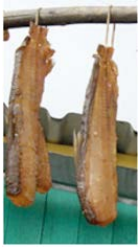
The ridge is taken in the hand, pulled towards itself, clipping it in the direction of the tail, and cut off at the base of the caudal fin. Here, they make a through-cut and hang it for drying on special nails driven into hangers, or make knits for a pole. Sometimes this fish is also smoked.
Photo source: The kitchen of my childhood (Dolgan traditional cuisine) / author-comp. A.A. Barbolina; ed. V.G. Zavarzin. – Krasnoyarsk: OOO "New Equipment and Technologies", 2022. – 72 p. – (Preserving the lessons of the ancestors). – ISBN 978-5-98708-150-1
Fish broth - Һyanaan uһaata - Һыаҥаан уһаата
In freshly caught burbot, the abdomen is cut, the insides are removed, and the liver is separated. Burbot uses only the head and body, the tail part (5-7 mm) is thrown away (bait for Arctic fox). The gutted burbot is well washed from the mucus, cut into pieces and put in cold water, cook for 15-18 minutes, and 7 minutes before cooking, put the liver and salt. 3 minutes before full readiness, remove the meat, head, and liver separately into a bowl.
Large bones (vertebrates and other prickly ones) are extracted from the meat and placed in deep bowls. The liver is crushed and poured into the broth. Fill the bowls with meat and serve it on the table. Burbot ear is considered a delicacy, cooked only from freshly caught.
Photo source: The kitchen of my childhood (Dolgan traditional cuisine) / author-comp. A.A. Barbolina; ed. V.G. Zavarzin. – Krasnoyarsk: OOO "New Equipment and Technologies", 2022. – 72 p. – (Preserving the lessons of the ancestors). – ISBN 978-5-98708-150-1
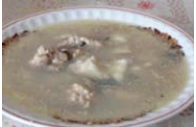
Boiled fish - balyk miine - балык минэ
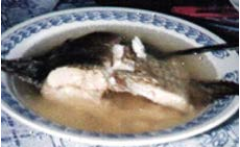
Fish (broad whitefish, whitefish, big powan, trout, char) are processed, that is, cleaned of scales and viscera, and cut into portions. Thoroughly washed, and then lowered into a pot of cold water and boiled for 15-18 minutes, and 7 minutes before cooking, add salt. The pieces of fish are taken out of the broth, placed in one large dish and served on the table. The broth is served separately in mugs or bowls, and sometimes fish is served with broth.
Photo source: The kitchen of my childhood (Dolgan traditional cuisine) / author-comp. A.A. Barbolina; ed. V.G. Zavarzin. – Krasnoyarsk: OOO "New Equipment and Technologies", 2022. – 72 p. – (Preserving the lessons of the ancestors). – ISBN 978-5-98708-150-1
Baked fish, fish liver, deer liver, goose liver, duck liver - ueluu (balyk, byar) - үөлүү (балык, быар
Freshly caught fish (broad whitefish, whitefish, char) are cleaned of scales, the insides are removed, rubbed inside and out with salt and pricked on a twig. Bake on a fire for 20-25 minutes, turning it over often. Sometimes fish is baked unpeeled in sand or clay around a campfire. The unpeeled fish turns out to be very juicy and tasty. The liver of fish, deer, goose, and duck is also baked. Ueluu is a regular dish of shepherds, fishermen, and hunters. Ueluu is a purely folk dish, healthy and nutritious.
Балык ыһаарыта – рыба жареная
 Freshly caught fish (broad whitefish, whitefish, char) are cleaned of scales, the insides are removed, rubbed inside and out with salt and pricked on a twig. Bake on a fire for 20-25 minutes, turning it over often. Sometimes fish is baked unpeeled in sand or clay around a campfire. The unpeeled fish turns out to be very juicy and tasty. The liver of fish, deer, goose, and duck is also baked. Ueluu is a regular dish of shepherds, fishermen, and hunters. Ueluu is a purely folk dish, healthy and nutritious.
Freshly caught fish (broad whitefish, whitefish, char) are cleaned of scales, the insides are removed, rubbed inside and out with salt and pricked on a twig. Bake on a fire for 20-25 minutes, turning it over often. Sometimes fish is baked unpeeled in sand or clay around a campfire. The unpeeled fish turns out to be very juicy and tasty. The liver of fish, deer, goose, and duck is also baked. Ueluu is a regular dish of shepherds, fishermen, and hunters. Ueluu is a purely folk dish, healthy and nutritious.
Photo source: The kitchen of my childhood (Dolgan traditional cuisine) / author-comp. A.A. Barbolina; ed. V.G. Zavarzin. – Krasnoyarsk: OOO "New Equipment and Technologies", 2022. – 72 p. – (Preserving the lessons of the ancestors). – ISBN 978-5-98708-150-1
Slices of frozen fish or meat served cold (stroganina) - kyspyt - кыспыт
For a long time, the best fish (broad whitefish, whitefish) have been taken for this dish. The fish should be oily, properly frozen (without frost, not crushed, not bent), freshly frozen (gills are bright red, eyes are transparent, scales fit snugly to the skin, without spots). A well-frozen fish is brought in, allowed to lie down for 5 minutes, then the fins are cut off, the skin is incised with the sharp end of a knife on both sides of the abdomen, two strips are also on the back, the skin is removed, holding the head with a rag. The cleaned fish begins to be whittled from the tail down to the head. They are planed in smooth thin layers. It is served on the table in a large dish, consumed with salt. Sometimes a heavily frozen huge broad whitefish or whitefish is put in the oven and the scales are cleaned, the skin is removed. The skin is cut into small pieces, dipped in salt and eaten. Everything goes to stroganina – liver, insides, head.
Kyspyt is a favourite dish of northern people. It's nuticious and very popular.
Photo source: The Red North website. URL: https://ks-yanao.ru/news/obschestvo/idealno-tonko-kak-gotovyat-stroganinu-izvestnye-khanty
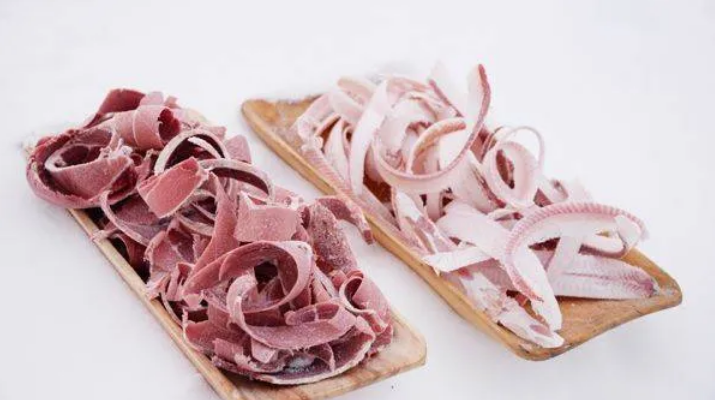
Fresh fish meat - honudai - Һоҥудайы
For this dish, they take freshly caught fish (broad whitefish, bull trout, crucian carp, Arctic cisco, whitefish, white salmon), which is still trembling. The fish is cleaned of scales, the insides are removed, the blood is removed with a spoon and served on the table. The prepared fish is cut into portions 5-7 cm wide, then each person serves himself: cuts into small pieces (cubes) and consumes with salt. Honudai (fresh meat) is a specific dish, tasty and healthy.
Fish oil - balyk hyata - балык һыата
In the tundra, there was waste-free production in traditional life, only overcooked bones remained from fish, and then for deer dogs. Fish oil was prepared from the heads, bones of the spinal column, and internal fat. When making different types of yukola, heads and spinal ridges were collected, and then boiled and fat was removed from the broth during cooking. The internal fat was collected separately into a bowl and melted in a frying pan over low heat, then filtered, as blood clots came across. After that, the fish oil was boiled over low heat until it formed an amber color, if overexposed, it gave off fumes, it tasted bitter.
The composition of fish oil includes vitamins A and D, and the content of these nutrients is very high. Fish oil was stored in glass bottles, enameled cans, and in traditional life it was stored in bags made of pike or burbot skin.
Fish, with a hint of meat - iin balyga, iin ete - иин балыга, иин этэ
When there were a lot of fish, the housewives did not have time to process it, and elderly people in places of spring and autumn corral dug cellars for storing fish, meat and game. The fish was put in a basin, lightly sprinkled with coarse salt and put in a cool place overnight, then allowed to drain a little brine, laid out on logs or a bunch of dwarf birches. After that, they were stored in the cellar, and left there for 3-4 months. During this time, the fish was preserved in the permafrost, covered with a light coating of honey. Iin balyga – a fish with a smell – is designed for an amateur.
The older generation used it with great pleasure: they boiled, dried and ate low-salted (low-salted). Meat was also preserved. The frozen carcass was sawed into pieces along with the skin, without stripping, so that the meat would not chafe, and stored in the cellar all summer.
Wildfowl dishes - keureurdeur etteritten astar - көтөрдөр эттэриттэн астар
Soups of partridge, goose and duck - kurpaasky, kaas, kus miine - курпааскы, каас, кус минэ
The partridge is pulled immediately, while the carcass is still warm, then it is cleaned easily, so hunters sometimes pull themselves, if there are few partridges, they bring home already cleaned of feathers. The stale game (partridge, goose, duck, loon, etc.) is put in boiling water for a few minutes, only then they begin to pluck feathers and fluff. Geese and ducks are necessarily singed over a campfire. The game is cut up, washed and put in cold water, boiled for 20-25 minutes, and 10 minutes before cooking, add salt. Geese and ducks are boiled for 30-40 minutes. If the game is fatty, remove the fat from the broth separately in a small bowl.
Wildfowl meat is served on the table in a large plate, broth and fat separately in bowls. Meat is dipped in fat. Sometimes Dolgan soup (flour soup) is made from broth.
Photo source: Arguments and Facts. URL: https://ugra.aif.ru/food/1340016

Wildfowl stew (loon, goose) - kuogas, kaas koltoto - куогас, каас колтото
Sometimes in the hot summer or late autumn, a loon gets caught in the nets. It is very dangerous for fishermen who are in a canvas or dilapidated wooden branch (boat). The loons do not pluck feathers, fluff, but mostly take off their skins. The peeled skin was also used. She went to lubricate mats, leather shoes, and harness things from deer skins so that it would not get wet and rot. The loon was cut up, the flesh was removed separately, and the bones were left for broth. The prepared flesh (from two or more loons) was cut into small pieces (cubes), the inner fat was melted in a deep frying pan, this meat was put and fried. Then the fried meat was transferred to a saucepan, finely chopped wild onions, salt were added there, and all this was poured with broth and fat so that the liquid completely covered the products. The pan was put on fire, covered with a lid and stewed until ready.
It was served in a deep bowl, as this traditional dish is very fatty. Such a dish was also prepared from the flesh of geese, and sometimes assorted loon and goose meat was prepared. Koltoto – wildfowl stew was prepared depending on the availability of the product. A rare dish, but very specific, delicious.
Goose meat with a whiff - iin kaahyn ete - иин кааһын этэ
In the spring, elderly people made food preparations for autumn, for winter, in case of "crop failure" of wild deer, unsuccessful fishing. In the spring, during the calving period, before the summer argish, meat was left in the cellars – venison, game, fish. The gutted, butchered, prepared goose (two or more) was put into a bag made of loon skin, tightly sewn up and put in the cellar for 2-3 months. The wildfowl meat that has been lying for so long does not lose its taste when properly stored, you can cook any dish from it, whether it's soup or stew. The meat of the game becomes even softer, more tender. Iin kaahyn ete is a favorite dish of tundra people, especially the older generation.
Boiled egg - busput himiit - буспут һымыыт
In the summer, when it is possible (during during the nomadic period, hunting for wildfowl), tundra farmers use boiled eggs of partridges, geese, ducks, loons in their diet. Eggs are put in cold water, boiled for 7-10 minutes, then dipped in cold water to cool and served on the table.
Flour products - burdugunan onorullubut astar - бурдугунан оҥоруллубут астар
Dolgan bread - keuteuguu - көтөгүү
 3-4 cups of wheat flour, 1 teaspoon of salt, a little yeast, warm water. Mix flour, salt, yeast and gradually add water until the dough can be kneaded. Knead for 10 minutes, cover, even wrap, and put in a warm place until the dough rises.
3-4 cups of wheat flour, 1 teaspoon of salt, a little yeast, warm water. Mix flour, salt, yeast and gradually add water until the dough can be kneaded. Knead for 10 minutes, cover, even wrap, and put in a warm place until the dough rises.
Heat the pan, grease with goose fat and pour the dough over the entire area of the pan. When bubbles appear and a golden crust forms, turn it over carefully and fry the other side. Keuteuguu – bread is removed from the pan and smeared on both sides with melted butter or goose fat, put on an edge until it cools, slightly propped up with a wooden stirrer - bulaak. The bread turns out to be very porous, 4-6 cm thick, and delicious. Keuteuguu is used with different fats (goose, fish, foot marrow).
Photo source: The kitchen of my childhood (Dolgan traditional cuisine) / author-comp. A.A. Barbolina; ed. V.G. Zavarzin. – Krasnoyarsk: OOO "New Equipment and Technologies", 2022. – 72 p. – (Preserving the lessons of the ancestors). – ISBN 978-5-98708-150-1
Unleavened flatbread - katarba - катарба
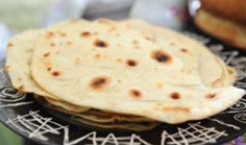 Two cups of wheat flour, warm water, salt. Mix flour, salt and water until the flour turns into a stiff dough. It is divided into pieces, rolled out according to the size of a frying pan with a thickness of 5 mm. Heat a frying pan, grease it and put the dough. When a golden crust is formed, the second side is turned over and fried. Remove the flatbread onto a shallow dish. Several flatbreads are fried at a time, depending on the number of family members and their appetite. The flatbread is torn with your hands and eaten with any dish.
Two cups of wheat flour, warm water, salt. Mix flour, salt and water until the flour turns into a stiff dough. It is divided into pieces, rolled out according to the size of a frying pan with a thickness of 5 mm. Heat a frying pan, grease it and put the dough. When a golden crust is formed, the second side is turned over and fried. Remove the flatbread onto a shallow dish. Several flatbreads are fried at a time, depending on the number of family members and their appetite. The flatbread is torn with your hands and eaten with any dish.
Photo source: The kitchen of my childhood (Dolgan traditional cuisine) / author-comp. A.A. Barbolina; ed. V.G. Zavarzin. – Krasnoyarsk: OOO "New Equipment and Technologies", 2022. – 72 p. – (Preserving the lessons of the ancestors). – ISBN 978-5-98708-150-1
Pancakes - alaadjy - алаадьы
3-4 cups of flour, 1 teaspoon of salt, a little baking sodium carbonate (soda), warm water. Mix flour, salt, baking soda and water. Knead so that there are no lumps in the dough. Heat a frying pan, pour in the fat, then spread the dough with a spoon and fry until light brown crusts form on both sides. Remove the pancakes into a large shallow dish.
Oatmeal - kerierdii - кэриэрдии
The inner fat of the deer (ithir, acha) is cut into a frying pan and melted, then 2-3 cups of flour are poured and fried, stirring with a wooden stirrer (bulaak). Kerierdii (oatmeal) are fried until a light brown color is formed. Remove the oatmeal into a bowl and serve with tea. Store the oatmeal in a dry place. Kerierdii is a very hearty dish, it is very popular at all times.
Wild vegetable and vitamin plants - hir uuneeyilere - Һир үүнээйилэрэ
Wild vegetable and vitamin-bearing plants are suppliers of vitamins, trace elements and other nutrients necessary for normal human life. Dolgans knew about this and were used in the diet as a healthdul food, since many of them contain biologically active substances that contribute to the prevention of certain human diseases.
Wild tundra onion - luuk - луук
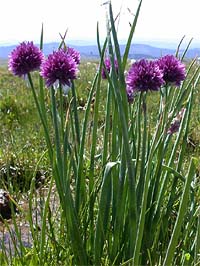

Wild onion is a perennial herbaceous plant. Erect, up to 60 cm tall, grows in floodplain meadows along river banks. The stem is leafless, thin. Blooms in June and July in the form of an umbrella of spherical pink or lilac-pink color. Leaves and bulbs are used for food.
Photo source:
"Encyclopedia of ornamental garden plants". URL: http://flower.onego.ru/lukov/allium_v.html
The kitchen of my childhood (Dolgan traditional cuisine) / author-comp. A.A. Barbolina; ed. V.G. Zavarzin. – Krasnoyarsk: OOO "New Equipment and Technologies", 2022. – 72 p. – (Preserving the lessons of the ancestors). – ISBN 978-5-98708-150-1
Сommon sorrel - miinne uurar uuneeyi (ot) - мииҥҥэ уурар үүнээйи (от)
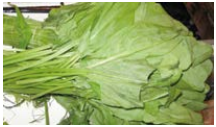 Sorrel is a perennial herbaceous plant. It grows in meadows and grassy hillsides. Tundra farmers eat sorrel in its raw form while grazing the herd.
Sorrel is a perennial herbaceous plant. It grows in meadows and grassy hillsides. Tundra farmers eat sorrel in its raw form while grazing the herd.
Photo source: The kitchen of my childhood (Dolgan traditional cuisine) / author-comp. A.A. Barbolina; ed. V.G. Zavarzin. – Krasnoyarsk: OOO "New Equipment and Technologies", 2022. – 72 p. – (Preserving the lessons of the ancestors). – ISBN 978-5-98708-150-1
Rhodiola rosea - umuyak - умуйак
Rhodiola is easily recognized by its thick leaves and bright flower. It grows along sandy riverbanks. Deer are very fond of her, they identify delicious healthy roots by their smell and pull them out with their hooves. The most remarkable thing about Rhodiola rosea is the root, it looks golden and has properties too. It increases the body's stability and efficiency.
Photo source: The kitchen of my childhood (Dolgan traditional cuisine) / author-comp. A.A. Barbolina; ed. V.G. Zavarzin. – Krasnoyarsk: OOO "New Equipment and Technologies", 2022. – 72 p. – (Preserving the lessons of the ancestors). – ISBN 978-5-98708-150-1
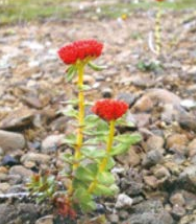
Rhubarb - istie - истиэ
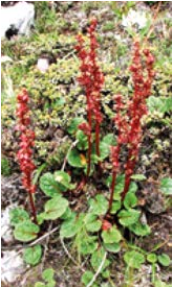 Rhubarb in the tundra grows on sandy-pebble soil and in a rocky valley along the banks of rivers and streams. It grows mainly scattered, in single specimens or in small groups. It blooms in May-June, bears fruit in July. The stems are long, with small red flowers at the top. The aboveground part contains oxalic, malic, citric and ascorbic acids.
Rhubarb in the tundra grows on sandy-pebble soil and in a rocky valley along the banks of rivers and streams. It grows mainly scattered, in single specimens or in small groups. It blooms in May-June, bears fruit in July. The stems are long, with small red flowers at the top. The aboveground part contains oxalic, malic, citric and ascorbic acids.
Photo source: The kitchen of my childhood (Dolgan traditional cuisine) / author-comp. A.A. Barbolina; ed. V.G. Zavarzin. – Krasnoyarsk: OOO "New Equipment and Technologies", 2022. – 72 p. – (Preserving the lessons of the ancestors). – ISBN 978-5-98708-150-1
Wild fruit and berry and nut-bearing plants
If wild vegetable and vitamin-bearing plants were used little in traditional food, then fruit and berry and nut–bearing plants are well known to Dolgans - Popigai tundra dwellers living in the forest tundra and tundra in the east of the Khatanga settlement.
Berries - hugunnar - һугуннар
Rosehip - deuluhuen - дөлүһүөн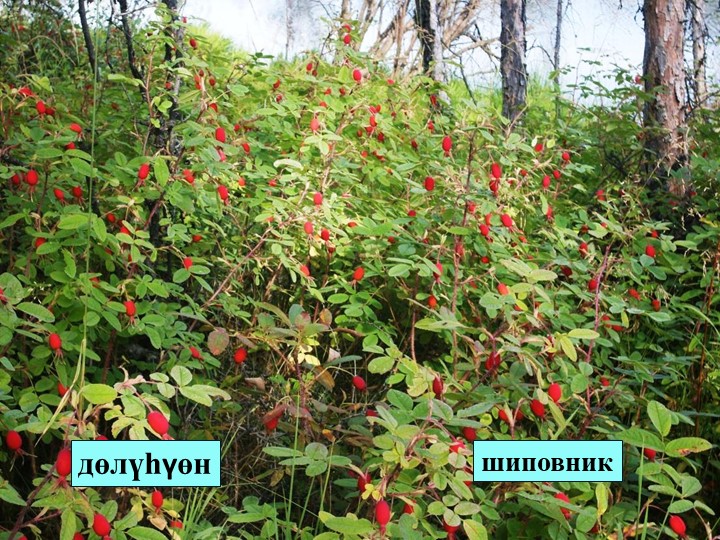 Rosehip (deuluhuen) is a prickly low shrub from the Rosaceae family. The rosehip has a trunk and old branches with brown bark, and thin annual shoots are covered with shiny brown-red bark. The rosehip shoots are covered with thorns, which are small, hard, slightly curved at the top. The flowers are solitary with five pink, occasionally red petals.
Rosehip (deuluhuen) is a prickly low shrub from the Rosaceae family. The rosehip has a trunk and old branches with brown bark, and thin annual shoots are covered with shiny brown-red bark. The rosehip shoots are covered with thorns, which are small, hard, slightly curved at the top. The flowers are solitary with five pink, occasionally red petals.
It grows along the banks of rivers and lakes, on the sunny side of the hills. It ripens at the end of July – in August. Rosehip fruits are used for food. Drinks are prepared from them, thrown into tea.
Photo source: Plants of Yakutia. URL: https://infourok.ru/prezentaciya-na-temu-rasteniya-yakutii-817092.html
Cloudberry - moroosko - морооско
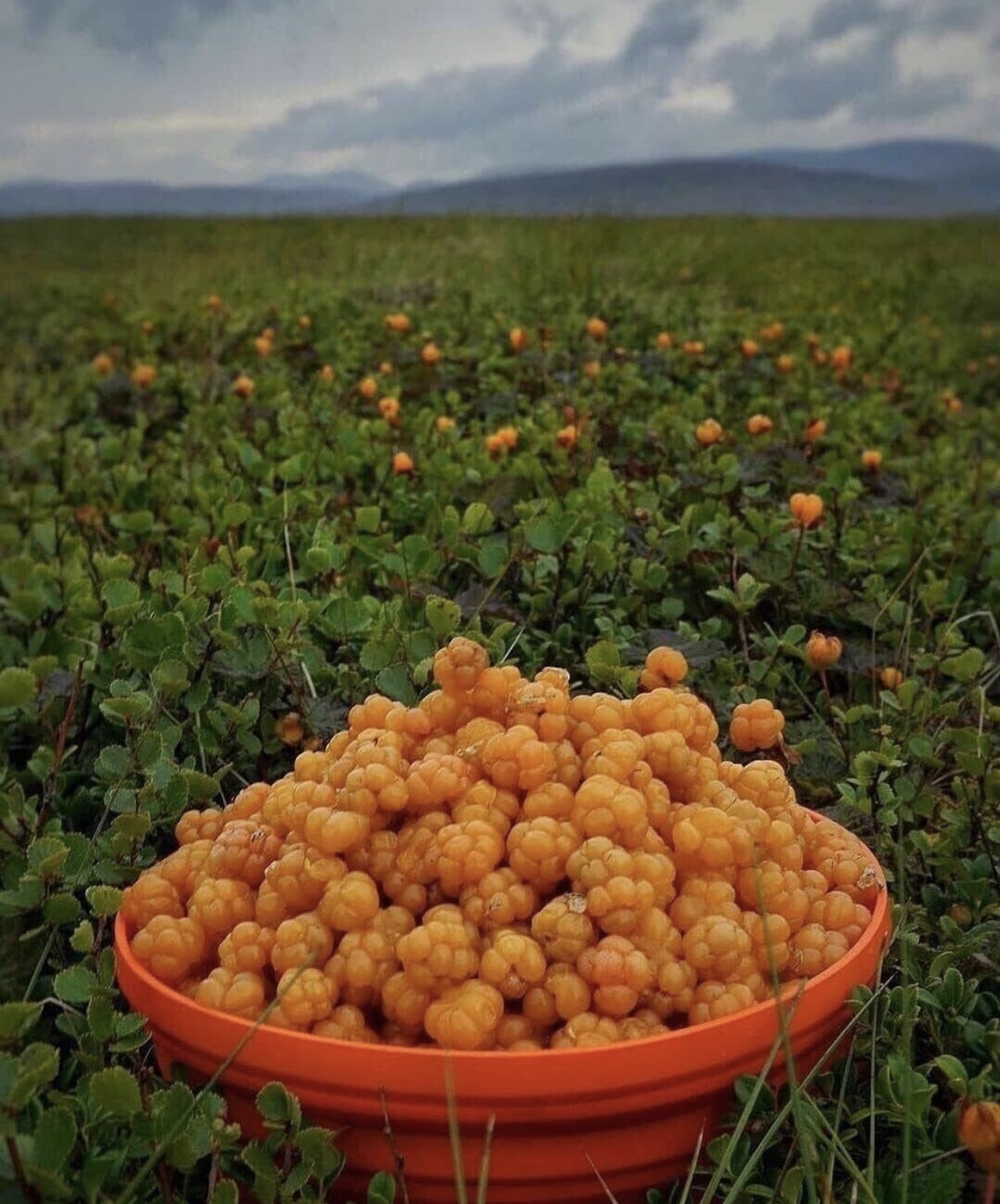
Cloudberry is a perennial herbaceous plant. The leaves are threefold, covered from below with thick silky hairs. The petioles of the leaves are short. The flowers are white. The fruits are spherical, reddish, very fragrant, if ripe, they are well separated from the flowering plant.
It blooms in June, the fruits ripen in July. It grows in open peat meadows, sometimes in thickets of shrubs on grassy slopes. The fruits are used fresh and processed.
Photo source:
The cloudberry season is considered open. URL: https://pikabu.ru/story/sezon_moroshki_schitaetsya_otkryityim_8365685?utm_source=linkshare&utm_medium=sharing
The kitchen of my childhood (Dolgan traditional cuisine) / author-comp. A.A. Barbolina; ed. V.G. Zavarzin. – Krasnoyarsk: OOO "New Equipment and Technologies", 2022. – 72 p. – (Preserving the lessons of the ancestors). – ISBN 978-5-98708-150-1

Blueberry - kuek hugun - күөк һугун
 Blueberry is a highly branched shrub, 30 cm high. The leaves are elliptical or oval, green above, bluish below. The leaves are on short petioles, they fall off in winter. The flowers are white. It blooms in June, the berries ripen at the end of July – in August. It grows in damp places and in the moss tundra. The berry is used fresh, jam is brewed.
Blueberry is a highly branched shrub, 30 cm high. The leaves are elliptical or oval, green above, bluish below. The leaves are on short petioles, they fall off in winter. The flowers are white. It blooms in June, the berries ripen at the end of July – in August. It grows in damp places and in the moss tundra. The berry is used fresh, jam is brewed.
Photo source: Kyym. Blueberry pickers. URL: https://kyym.ru/sonunnar/ajymny/dyl-a/6677-sugunnuttar
Lingonberry - oton - отон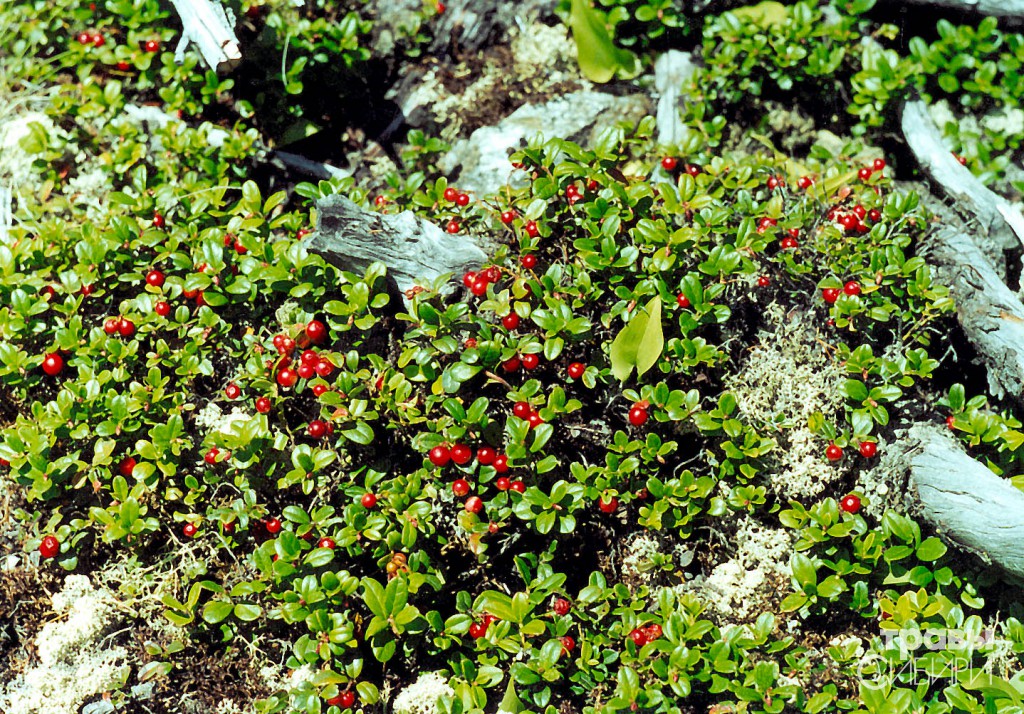 Lingonberry is a perennial low evergreen semi–shrub. It has leathery, dark green shiny leaves on top, they are light green with dark brown veins on the bottom. The leaves are elliptical, blunt at the edge. The flowers are collected in thick apical brushes on short pedicels. The corolla is bell-shaped white with four teeth. Cranberries bloom in June, and bright red berries ripen in August or early September.
Lingonberry is a perennial low evergreen semi–shrub. It has leathery, dark green shiny leaves on top, they are light green with dark brown veins on the bottom. The leaves are elliptical, blunt at the edge. The flowers are collected in thick apical brushes on short pedicels. The corolla is bell-shaped white with four teeth. Cranberries bloom in June, and bright red berries ripen in August or early September.
Photo source: Herbs of Siberia. URL: http://travasib.com/sprav/s-b/50-brusnika-obyknovennaya-brusnicya-rodokokkum-uulah-oton.html
Siberian shiksha - chiichaakh huguna - чыычаах һугуна
Vodyanika, or shiksha, is an evergreen shrub with creeping woody branches. Watermelon berries are sweet.
Photo source: Floristry Info. URL: https://floristics.info/ru/stati/sad/4152-vodyanika-shiksha-svojstva-i-protivopokazaniya-posadka-i-ukhod.html
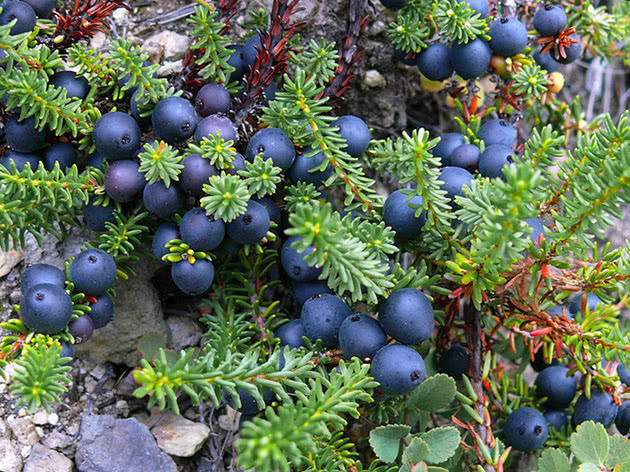
Red currant - kaptagas - каптагас
 Currant is a shrub. The leaves are wide, 3-5-lobed, mostly fluffy from below. The berry is red. It blooms in June, bears fruit in July and August. It grows in damp places, along the banks of rivers and streams, in thickets of shrubs. Berries are eaten raw as a source of vitamins.
Currant is a shrub. The leaves are wide, 3-5-lobed, mostly fluffy from below. The berry is red. It blooms in June, bears fruit in July and August. It grows in damp places, along the banks of rivers and streams, in thickets of shrubs. Berries are eaten raw as a source of vitamins.
Sources:
- The kitchen of my childhood (Dolgan traditional cuisine) / author-comp. A.A. Barbolina; ed. V.G. Zavarzin. – Krasnoyarsk: OOO "New Equipment and Technologies", 2022. – 72 p. – (Preserving the lessons of the ancestors). – ISBN 978-5-98708-150-1
- Chuprina, A. T. Seasonality of traditional food culture dolgan / A. T. Chuprina, S. L. Chernyshova // Nutrition systems of the indigenous peoples of the Arctic – the role of traditional knowledge for sustainable development. – Moscow : Paulsen, 2018. – pp. 23-36. – EDN YOLATR.



